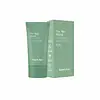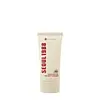What's inside
What's inside
 Key Ingredients
Key Ingredients

 Benefits
Benefits

 Concerns
Concerns

No concerns
 Ingredients Side-by-side
Ingredients Side-by-side

Water
Skin ConditioningPropanediol
SolventHomosalate
Skin ConditioningButyloctyl Salicylate
Skin ConditioningEthylhexyl Salicylate
UV AbsorberCI 77891
Cosmetic ColorantDiethylamino Hydroxybenzoyl Hexyl Benzoate
UV FilterSilica
AbrasiveAcrylates Copolymer
Polysorbate 60
EmulsifyingGlyceryl Stearate
EmollientBeeswax
Emulsion StabilisingBis-Ethylhexyloxyphenol Methoxyphenyl Triazine
Skin ConditioningCetyl Dimethicone
EmollientSodium Stearoyl Lactylate
EmulsifyingPEG-100 Stearate
Caprylyl Glycol
EmollientC20-22 Alkyl Phosphate
EmulsifyingSorbitan Stearate
EmulsifyingAluminum Hydroxide
EmollientC20-22 Alcohols
Emulsion StabilisingPolyhydroxystearic Acid
EmulsifyingPortulaca Oleracea Extract
Skin ConditioningStearic Acid
CleansingParfum
MaskingXanthan Gum
EmulsifyingAcrylamide/Sodium Acryloyldimethyltaurate Copolymer
Emulsion Stabilising1,2-Hexanediol
Skin ConditioningTromethamine
BufferingSodium Polyacryloyldimethyl Taurate
Emulsion StabilisingIsohexadecane
EmollientBenzotriazolyl Dodecyl P-Cresol
UV AbsorberNeopentyl Glycol Diethylhexanoate
EmollientDisodium EDTA
Polysorbate 80
EmulsifyingPPG-17
Skin ConditioningSorbitan Oleate
EmulsifyingMelaleuca Alternifolia Leaf Extract
PerfumingLactose
HumectantCentella Asiatica Extract
CleansingPhenethyl Alcohol
MaskingWater, Propanediol, Homosalate, Butyloctyl Salicylate, Ethylhexyl Salicylate, CI 77891, Diethylamino Hydroxybenzoyl Hexyl Benzoate, Silica, Acrylates Copolymer, Polysorbate 60, Glyceryl Stearate, Beeswax, Bis-Ethylhexyloxyphenol Methoxyphenyl Triazine, Cetyl Dimethicone, Sodium Stearoyl Lactylate, PEG-100 Stearate, Caprylyl Glycol, C20-22 Alkyl Phosphate, Sorbitan Stearate, Aluminum Hydroxide, C20-22 Alcohols, Polyhydroxystearic Acid, Portulaca Oleracea Extract, Stearic Acid, Parfum, Xanthan Gum, Acrylamide/Sodium Acryloyldimethyltaurate Copolymer, 1,2-Hexanediol, Tromethamine, Sodium Polyacryloyldimethyl Taurate, Isohexadecane, Benzotriazolyl Dodecyl P-Cresol, Neopentyl Glycol Diethylhexanoate, Disodium EDTA, Polysorbate 80, PPG-17, Sorbitan Oleate, Melaleuca Alternifolia Leaf Extract, Lactose, Centella Asiatica Extract, Phenethyl Alcohol
Water
Skin ConditioningPropanediol
SolventDibutyl Adipate
EmollientDiethylamino Hydroxybenzoyl Hexyl Benzoate
UV FilterButyloctyl Salicylate
Skin ConditioningEthylhexyl Triazone
UV AbsorberNiacinamide
SmoothingMethylene Bis-Benzotriazolyl Tetramethylbutylphenol
UV FilterPolymethylsilsesquioxane
Coco-Caprylate/Caprate
EmollientCaprylyl Methicone
Skin ConditioningDiethylhexyl Butamido Triazone
UV AbsorberGlycerin
HumectantPinus Sylvestris Bud Extract
PerfumingButylene Glycol
Humectant1,2-Hexanediol
Skin ConditioningPentylene Glycol
Skin ConditioningCardiospermum Halicacabum Flower/Leaf/Vine Extract
Skin ConditioningHedychium Coronarium Root Extract
MaskingEchium Plantagineum Seed Oil
Skin ConditioningBehenyl Alcohol
EmollientPoly C10-30 Alkyl Acrylate
Emulsion StabilisingPolyglyceryl-3 Methylglucose Distearate
EmulsifyingOctyldodecanol
EmollientDecyl Glucoside
CleansingTromethamine
BufferingCarbomer
Emulsion StabilisingAcrylates/C10-30 Alkyl Acrylate Crosspolymer
Emulsion StabilisingSodium Stearoyl Glutamate
CleansingPolyacrylate Crosspolymer-6
Emulsion StabilisingEthylhexylglycerin
Skin ConditioningAdenosine
Skin ConditioningHelianthus Annuus Seed Oil Unsaponifiables
EmollientXanthan Gum
EmulsifyingGlyceryl Caprylate
EmollientTocopherol
AntioxidantCeramide NP
Skin ConditioningCaprylyl Glycol
EmollientNonapeptide-1
Skin ConditioningAcetyl Hexapeptide-8
HumectantCopper Tripeptide-1
Skin ConditioningTripeptide-1
Skin ConditioningPalmitoyl Tetrapeptide-7
Skin ConditioningPalmitoyl Tripeptide-1
Skin ConditioningPalmitoyl Pentapeptide-4
Skin ConditioningHexapeptide-9
Skin ConditioningWater, Propanediol, Dibutyl Adipate, Diethylamino Hydroxybenzoyl Hexyl Benzoate, Butyloctyl Salicylate, Ethylhexyl Triazone, Niacinamide, Methylene Bis-Benzotriazolyl Tetramethylbutylphenol, Polymethylsilsesquioxane, Coco-Caprylate/Caprate, Caprylyl Methicone, Diethylhexyl Butamido Triazone, Glycerin, Pinus Sylvestris Bud Extract, Butylene Glycol, 1,2-Hexanediol, Pentylene Glycol, Cardiospermum Halicacabum Flower/Leaf/Vine Extract, Hedychium Coronarium Root Extract, Echium Plantagineum Seed Oil, Behenyl Alcohol, Poly C10-30 Alkyl Acrylate, Polyglyceryl-3 Methylglucose Distearate, Octyldodecanol, Decyl Glucoside, Tromethamine, Carbomer, Acrylates/C10-30 Alkyl Acrylate Crosspolymer, Sodium Stearoyl Glutamate, Polyacrylate Crosspolymer-6, Ethylhexylglycerin, Adenosine, Helianthus Annuus Seed Oil Unsaponifiables, Xanthan Gum, Glyceryl Caprylate, Tocopherol, Ceramide NP, Caprylyl Glycol, Nonapeptide-1, Acetyl Hexapeptide-8, Copper Tripeptide-1, Tripeptide-1, Palmitoyl Tetrapeptide-7, Palmitoyl Tripeptide-1, Palmitoyl Pentapeptide-4, Hexapeptide-9
 Reviews
Reviews

Ingredients Explained
These ingredients are found in both products.
Ingredients higher up in an ingredient list are typically present in a larger amount.
1,2-Hexanediol is a synthetic liquid and another multi-functional powerhouse.
It is a:
- Humectant, drawing moisture into the skin
- Emollient, helping to soften skin
- Solvent, dispersing and stabilizing formulas
- Preservative booster, enhancing the antimicrobial activity of other preservatives
Butyloctyl Salicylate is a chemical UV filter structurally similar to octisalate. It is a photostabilizer, SPF booster, emollient and solvent. This ingredient helps evenly spread out ingredients.
According to a manufacturer, it is suitable for pairing with micro Titanium Dioxide, Zinc Oxide, and pigments.
Photostabilizers help stabilize UV-filters and prevents them from degrading quickly.
Learn more about Butyloctyl SalicylateCaprylyl Glycol is a humectant and emollient, meaning it attracts and preserves moisture.
It is a common ingredient in many products, especially those designed to hydrate skin. The primary benefits are retaining moisture, skin softening, and promoting a healthy skin barrier.
Though Caprylyl Glycol is an alcohol derived from fatty acids, it is not the kind that can dry out skin.
This ingredient is also used as a preservative to extend the life of products. It has slight antimicrobial properties.
Learn more about Caprylyl GlycolDiethylamino Hydroxybenzoyl Hexyl Benzoate (DHHB) is a chemical UV-A absorber. It is formulated for high UVA protection (320-400 nm).
DHHB is well-liked for:
DHHB has been approved by the EU, Japan, Taiwan, and South America for use up to 10%. Unfortunately, it has not been approved for use in the US or Canada due to slow regulatory processes.
This ingredient is soluble in oils, fats, and lipids.
Learn more about Diethylamino Hydroxybenzoyl Hexyl BenzoatePropanediol is an all-star ingredient. It softens, hydrates, and smooths the skin.
It’s often used to:
Propanediol is not likely to cause sensitivity and considered safe to use. It is derived from corn or petroleum with a clear color and no scent.
Learn more about PropanediolTromethamine helps balance the pH and improve the texture of a product. It is synthetically created.
As an emulsifier, Tromethamine prevents oil and water ingredients from separating. This helps stabilize the product and elongate a product's shelf life. Tromethamine also makes a product thicker.
Tromethamine helps balance the pH level of a product. Normal pH level of skin is slightly acidic (~4.75-5.5). The acidity of our skin is maintained by our glands and skin biome. Being slightly acidic allows our skin to create an "acid mantle". This acid mantle is a thin barrier that protects our skin from bacteria and contaminants.
Oral Tromethanmine is an anti-inflammatory drug but plays the role of masking, adding fragrance, and/or balancing pH in skincare.
1,3-Propanediol, 2-amino-2-(hydroxymethyl)-
Learn more about TromethamineWater. It's the most common cosmetic ingredient of all. You'll usually see it at the top of ingredient lists, meaning that it makes up the largest part of the product.
So why is it so popular? Water most often acts as a solvent - this means that it helps dissolve other ingredients into the formulation.
You'll also recognize water as that liquid we all need to stay alive. If you see this, drink a glass of water. Stay hydrated!
Learn more about WaterXanthan gum is used as a stabilizer and thickener within cosmetic products. It helps give products a sticky, thick feeling - preventing them from being too runny.
On the technical side of things, xanthan gum is a polysaccharide - a combination consisting of multiple sugar molecules bonded together.
Xanthan gum is a pretty common and great ingredient. It is a natural, non-toxic, non-irritating ingredient that is also commonly used in food products.
Learn more about Xanthan Gum